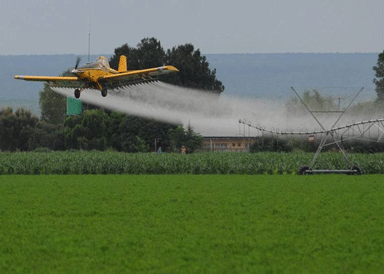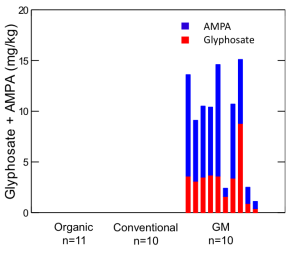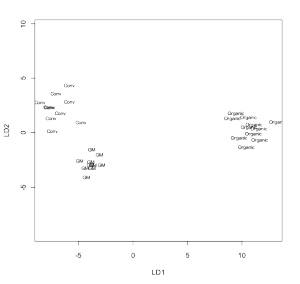By Thomas Bøhn and Marek Cuhra
Food and feed quality are crucial to human and animal health. Quality can be defined as sufficiency of appropriate minerals, vitamins and fats, etc. but it also includes the absence of toxins, whether man-made or from other sources. Surprisingly, almost no data exist in the scientific literature on herbicide residues in herbicide tolerant genetically modified (GM) plants, even after nearly 20 years on the market.
In research recently published by our laboratory (Bøhn et al. 2014) we collected soybean samples grown under three typical agricultural conditions: organic, GM, and conventional (but non-GM). The GM soybeans were resistant to the herbicide Roundup, whose active ingredient is glyphosate.
We tested these samples for nutrients and other compounds as well as relevant pesticides, including glyphosate and its principal breakdown product, Aminomethylphosponic acid (AMPA). All of the individual samples of GM-soy contained residues of both glyphosate and AMPA, on average 9.0 mg/kg. This amount is greater than is typical for many vitamins. In contrast, no sample from the conventional or the organic soybeans showed residues of these chemicals (Fig. 1).

This demonstrates that Roundup Ready GM-soybeans sprayed during the growing season take up and accumulate glyphosate and AMPA. Further, what has been considered a working hypothesis for herbicide tolerant crops, i.e. that, as resistant weeds have spread:
“there is a theoretical possibility that also the level of residues of the herbicide and its metabolites may have increased” (Kleter et al. 2011)
is now shown to be actually happening.
Monsanto (manufacturer of glyphosate) has claimed that residues of glyphosate in GM soy are lower than in conventional soybeans, where glyphosate residues have been measured up to 16-17 mg/kg (Monsanto 1999). These residues, found in non-GM plants, likely must have been due to the practice of spraying before harvest (for desiccation). Another claim of Monsanto’s has been that residue levels of up to 5.6 mg/kg in GM-soy represent

“…extreme levels, and far higher than those typically found” (Monsanto 1999).
Seven out of the 10 GM-soy samples we tested, however, surpassed this “extreme level” (of glyphosate + AMPA), indicating a trend towards higher residue levels. The increasing use of glyphosate on US Roundup Ready soybeans has been documented (Benbrook 2012). The explanation for this increase is the appearance of glyphosate-tolerant weeds (Shaner et al. 2012) to which farmers are responding with increased doses and more applications.
Maximum residue levels (MRLs) of glyphosate in food and feed
Globally, glyphosate-tolerant GM soy is the number one GM crop plant and glyphosate is the most widely used herbicide, with a global production of 620 000 tons in 2008 (Pollak 2011). The world soybean production in 2011 was 251.5 million metric tons, with the United States (33%), Brazil (29%), Argentina (19%), China (5%) and India (4%) as the main producing countries (American Soybean Association 2013).
In 2011-2012, soybeans were planted on about 30 million hectares in the USA, with Roundup Ready GM soy contributing 93-94 % of the production (USDA 2013). Globally, Roundup Ready GM soybeans contributed to 75 % of the production in 2011 (James 2012).
The legally acceptable level of glyphosate contamination in food and feed, i.e. the maximum residue level (MRL) has been increased by authorities in countries where Roundup-Ready GM crops are produced, or where such commodities are imported. In Brazil, the MRL in soybean was increased from 0.2 mg/kg to 10 mg/kg in 2004: a 50-fold increase, but only for GM-soy. The MRL for glyphosate in soybeans has been increased also in the US and Europe. In Europe, it was raised from 0.1 mg/kg to 20 mg/kg (a 200-fold increase) in 1999, and the same MRL of 20 mg/kg was adopted by the US. In all of these cases, MRL values appear to have been adjusted, not based on new scientific evidence, but pragmatically in response to actual observed increases in the content of residues in glyphosate-tolerant GM soybeans.
Has the toxicity of Roundup been greatly underestimated?
When regulatory agencies assess pesticides for safety they invariably test only the claimed active ingredient.
Nevertheless, these do not necessarily represent realistic conditions since in practice it is the full, formulated herbicide (there are many Roundup formulations) that is used in the field. Thus, it is relevant to consider, not only the active ingredient, in this case glyphosate and its breakdown product AMPA, but also the other compounds present in the herbicide formulation since these enhance toxicity. For example, formulations of glyphosate commonly contain adjuvants and surfactants to stabilize and facilitate penetration into the plant tissue. Polyoxyethylene amine (POEA) and polyethoxylated tallowamine (POE-15) are common ingredients in Roundup formulations and have been shown to contribute significantly to toxicity (Moore et al. 2012).
Our own recent study in the model organism Daphnia magna demonstrated that chronic exposure to glyphosate and a commercial formulation of Roundup resulted in negative effects on several life-history traits, in particular reproductive aberrations like reduced fecundity and increased abortion rate, at environmental concentrations of 0.45-1.35 mg/liter (active ingredient), i.e. below accepted environmental tolerance limits set in the US (0.7 mg/liter) (Cuhra et al. 2013). A reduced body size of juveniles was even observed at an exposure to Roundup at 0.05 mg/liter.
This is in sharp contrast to world-wide regulatory assumptions in general, which we have found to be strongly influenced by early industry studies and in the case of aquatic ecotoxicity assessment, to be based on 1978 and 1981 studies presented by Monsanto claiming that glyphosate is virtually non-toxic in D. magna (McAllister & Forbis, 1978; Forbis & Boudreau, 1981).
Thus a worrisome outlook for health and the environment can be found in the combination of i) the vast increase in use of glyphosate-based herbicides, in particular due to glyphosate-tolerant GM plants, and ii) new findings of higher toxicity of both glyphosate as an active ingredient (Cuhra et al., 2013) and increased toxicity due to contributions from chemical adjuvants in commercial formulations (Annett et al. 2014).
A similar situation can be found for other pesticides. Mesnage et al. (2014) found that 8 out of 9 tested pesticides were more toxic than their declared active principles.
This means that the Accepted Daily Intake (ADI) for humans, i.e. what society finds “admissible” regarding pesticide residues may have been set too high, even before potential combinatorial effects of different chemical exposures are taken into account.
For glyphosate formulations (Roundup), realistic exposure scenarios in the aquatic environment may harm non-target biodiversity from microorganisms, invertebrates, amphibians and fish, (reviewed in Annett et al. 2014) indicating that the environmental consequences of these agrochemicals need to be re-assessed.
Other compositional differences between GM, non-GM, and organic
Our research also demonstrated that different agricultural practices lead to markedly different end products.

Data on other measured compositional characteristics could be used to discriminate statistically all individual soy samples (without exception) into their respective agricultural practice background (Fig. 2).
Organic soybeans showed the healthiest nutritional profile with more glucose, fructose, sucrose and maltose, significantly more total protein, zinc and less fiber, compared with both conventional and GM-soy. Organic soybeans contained less total saturated fat and total omega-6 fatty acids than both conventional and GM-soy.
Conclusion
Roundup Ready GM-soy accumulates residues of glyphosate and AMPA, and also differs markedly in nutritional composition compared to soybeans from other agricultural practices. Organic soybean samples also showed a more healthy nutritional profile (e.g. higher in protein and lower in saturated fatty acids) than both industrial conventional and GM soybeans.
Lack of data on pesticide residues in major crop plants is a serious gap of knowledge with potential consequences for human and animal health. How is the public to trust a risk assessment system that has overlooked the most obvious risk factor for herbicide tolerant GM crops, i.e. high residue levels of herbicides, for nearly 20 years? If it has been due to lack of understanding, it would be bad. If it is the result of the producer’s power to influence the risk assessment system, it would be worse.
References
American Soy Association, Soystats. 2013. 16-5-2013.
Annett, R., Habibi, H. R. and Hontela, A. 2014. Impact of glyphosate and glyphosate-based herbicides on the freshwater environment. – Journal of Applied Toxicology DOI 10.1002/jat.2997.
Aumaitre, L. A. 2002. New feeds from genetically modified plants: substantial equivalence, nutritional equivalence and safety for animals and animal products. – Productions Animales 15: 97-108.
Benbrook, C. M. 2012. Impacts of genetically engineered crops on pesticide use in the U.S. – the first sixteen years. – Environmental Science Europe 24:24.
Binimelis, R., Pengue, W. and Monterroso, I. 2009. “Transgenic treadmill”: Responses to the emergence and spread of glyphosate-resistant johnsongrass in Argentina. – Geoforum 40: 623-633.
Bøhn, T., Cuhra, M., Traavik, T., Sanden, M., Fagan, J. and Primicerio, R. 2014. Compositional differences in soybeans on the market: Glyphosate accumulates in Roundup Ready GM soybeans. – Food Chemistry 153: 207-215.
Cuhra, M., Traavik, T. and Bøhn, T. 2013. Clone- and age-dependent toxicity of a glyphosate commercial formulation and its active ingredient in Daphnia magna. – Ecotoxicology 22: 251-262 (open access). DOI 10.1007/s10646-012-1021-1.
Duke, S. O., Rimando, A. M., Pace, P. F., Reddy, K. N. and Smeda, R. J. 2003. Isoflavone, glyphosate, and aminomethylphosphonic acid levels in seeds of glyphosate-treated, glyphosate-resistant soybean. – Journal of Agricultural and Food Chemistry 51: 340-344.
EC . Review report for the active substance glyphosate. 6511/VI/99-final, 1-56. 2002. European Commission. Health and Consumer Protection Directorate-General.
Forbis, A.D., Boudreau, P. 1981. Acute toxicity of MON0139 (Lot LURT 12011)(AB-81-074) To Daphnia magna: Static acute bio- assay report no. 27203. Unpublished study document from US EPA library
Harrigan, G. G., Ridley, G., Riordan, S. G., Nemeth, M. A., Sorbet, R., Trujillo, W. A., Breeze, M. L. and Schneider, R. W. 2007. Chemical composition of glyphosate-tolerant soybean 40–3-2 grown in Europe remains equivalent with that of conventional soybean (Glycine max L.). – Journal of Agricultural and Food Chemistry 55: 6160-6168.
James, C. Global Status of Commercialized Biotech/GM Crops: 2012. ISAAA Brief No. 44. 2012. ISAAA: Ithaca, NY.
Kleter, G. A., Unsworth, J. B. and Harris, C. A. 2011. The impact of altered herbicide residues in transgenic herbicide-resistant crops on standard setting for herbicide residues. – Pest Management Science 67: 1193-1210.
McAllister, W., Forbis A. 1978. Acute toxicity of technical glyphosate (AB–78–201) to Daphnia magna. Study reviewed and approved 8–30–85 by EEB/HED
Mesnage, R., Defarge, N., Vendômois, J. S. and Seralini, G. E. 2014. Major pesticides are more toxic to human cells than their declared active principles. – BioMed Research International http://dx.doi.org/10.1155/2014/179691.
Monsanto . Residues in Roundup Ready soya lower than conventional soy. http://www.monsanto.co.uk/news/99/june99/220699_residue.html . 1999.
Moore, L. J., Fuentes, L., Rodgers, J. H., Bowerman, W. W., Yarrow, G. K., Chao, W. Y. and Bridges, W. C. 2012. Relative toxicity of the components of the original formulation of Roundup (R) to five North American anurans. – Ecotoxicology and Environmental Safety 78: 128-133.
Pollak, P. 2011. Fine chemicals: the industry and the business. – Wiley.
Shaner, D. L., Lindenmeyer, R. B. and Ostlie, M. H. 2012. What have the mechanisms of resistance to glyphosate taught us? – Pest Management Science 68: 3-9.
USDA . National Agricultural Statistics Service. 2013. 16-5-2013.
The Authors:
Thomas Bøhn
GenØk – Centre for Biosafety, Tromsø, Norway
Professor of Gene Ecology, Faculty of Health Sciences, UiT The Arctic University of Norway
Marek Cuhra
GenØk – Centre for Biosafety, Tromsø, Norway
PhD student, Faculty of Health Sciences, UiT The Arctic University of Norway
If this article was useful to you please consider sharing it with your networks.



Thankyou for this, it supports the attitude of most in Europe that we will not have this type of industrial agriculture. In Britain we have an odd situation where against the majority view our government wants to promote G M tech. With US trying to bypass opposition by a dodgy trade deal (TTIP) and politicians eyeing potential profit this article will help resist this evil.
I am currently recovering from a harsh treatment regime for a rare and deadly form of cancer known as Mantle Cell Lymphoma, which has been linked to exposure to Roundup. While it is usually impossible to link a specific case of cancer to exposure to a specific toxin, it is also known that some percentage of all the cases of MCL result from exposure to Roundup and other pollutants. This is one more case of a corporation “externalizing” costs. I get cancer, suffer, eventually die, while Monsanto makes profits off of roundup and GMO crops, then uses those profits to influence policy so we can’t be protected from their misdeeds.
Rise up!
My Dad died from two aggressive cancers that are also *linked* to RoundUp.
They manufacture the pesticides that make us sick and and they make medicines and medical equipment that we require to stay alive. It’s the pesticide treadmill. They run the FDA, the USDA, our higher courts, they own the House, the Senate and they have deep rooted military ties. I suppose they are probably the most powerful corporate entity in the world.
http://www.organicconsumers.org/usda_watch.cfm
“There’s nothing they are leaving untouched: the mustard, the okra, the bringe oil, the rice, the cauliflower. Once they have established the norm: that seed can be owned as their property, royalties can be collected. We will depend on them for every seed we grow of every crop we grow. If they control seed, they control food, they know it – it’s strategic. It’s more powerful than bombs. It’s more powerful than guns. This is the best way to control the populations of the world.” —Vandana Shiva
Several studies have found a slight increase in Non-Hodgkin’s lymphomas among ag workers, and this is statistically associated with the most common chemicals used, including glyphosate. That doesn’t prove that glyphosate usage caused the lymphoma, but it’s worth considering. Exposure to glyphosate is of course lower among those of us who just consume the treated products. It’s interesting to note that incidence of NHL has been essentially constant over the last 20 years, at about 20/100,00 men and women per year in the U.S. Mantle cell lymphoma is a small part of this total, and studies are even less clear because of its low incidence. Nevertheless, if we’re being exposed to increasing doses of glyphosate, it’s not at this time associated with an increasing rate of NHL.
Bob
I am not sure if you are trying to imply that therefore increasing exposure to roundup/glyphosate isnt causing these illnesses but the increases in exposure to roundup likely to have occurred in the last five years or so are unlikely to immediately increase the incidence of the disease like lymphoma since there will be an unknown timelag. That is unless there is an immediate physiological causative action, like the kidney disease reports: http://rt.com/news/monsanto-roundup-kidney-disease-921/
We in Australia are just taking up GM. Within a couple of years we have had non-GM farms and organic farms contaminated. The agenda is to contaminate. Any number of petitions have been ignored. Luckily some farmers are waking up to the glyphosate and resistance problems as well as increased costs and decreased yields of GM – these farmers are not planting GM canola this year. However the pressure on non GM farmers and non-GM states in Australia is being applied. Monsanto has the ear of our governments. In Western Australia Monsanto has taken over 26% of our public grain research facility, Intergrain and they are vying for another 20%. Monsanto is also trying to get GM wheat tested in Australia. They have taken over some of our university agricultural research departments as well. Unfortunately most of our population don’t care or can’t see the danger to our own viable wheat industy, and our health.
I’m wondering about all the auto-immune conditions/diseases popping up that were foreign to us a decade ago? Could they be attributed to GM residue we’re ingesting?
This is scary we in NZ have also been force fed the TTIP because the politicians are not listening to those that vote them in, instead telling us they know best. I along with a lot of other people sufferfrom irritable bowel which is linked to fructose intolerance which is linked to the excesive amonts of sugar we are force fed in our commercially prepared food but also to leaky gut syndrome. I now am thinking is this linked to the amount of surficants that i have also unkowingly eaten if surficants breakdown cells in plants what do they do to us? Organic food is expensive the only way we can beat these guys is to have more and more organic farms which will assist to bring the prices down come on everyone lets raise the demand for organic
I think you mean surfactants, but yes, they do destroy membranes and your point is interesting, thank you.
For those who are interested, the authors published a more detailed review in April 2016: “Glyphosate: Too Much of a Good Thing?” by Marek Cuhra, Thomas Bøhn and Petr Cuhra, Frontiers in Environmental Science, Vol. 4, Article 28; April 2016 (14 pages) https://pdfs.semanticscholar.org/3310/c70a02a6947360371234f3b4110a821051a6.pdf …. This publication is also here in HTML format: http://journal.frontiersin.org/article/10.3389/fenvs.2016.00028/full
Do you suppose that GMO’s
Put glyphosates on dinner plates
Which make us sick
I’d rather pick ORGANIC!
I made this poem while I was at work recently.
I’m thankful there are a few good websites like this that tell the truth and the facts.